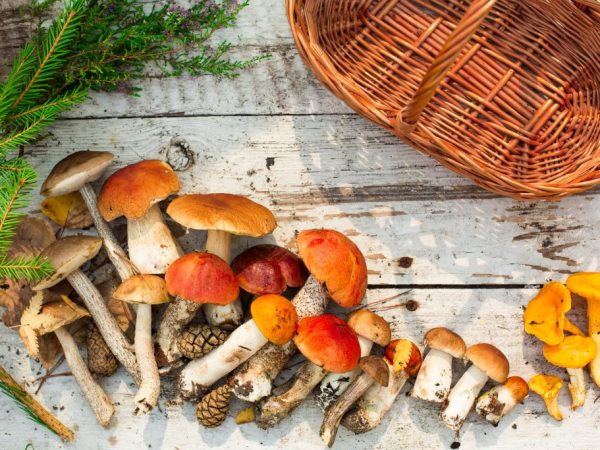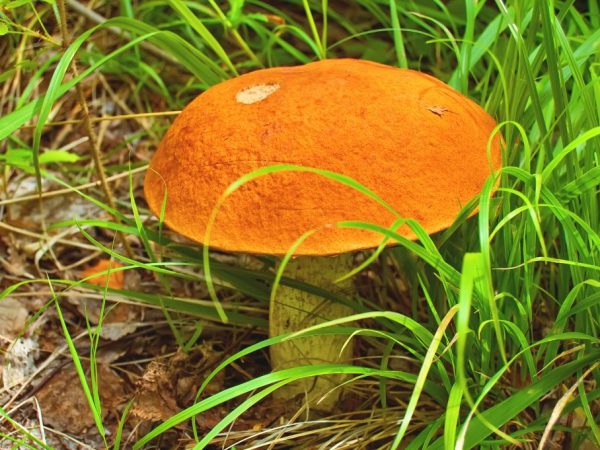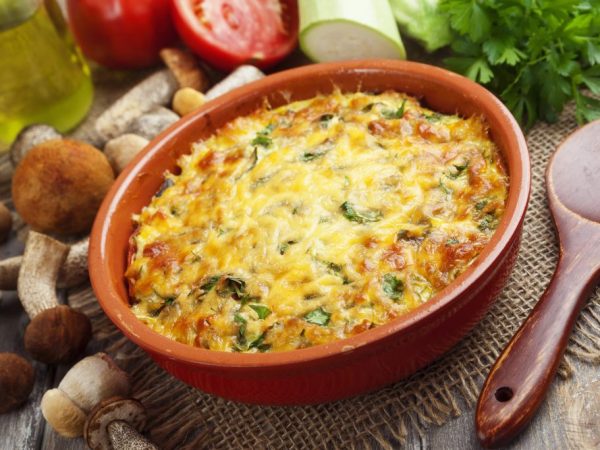Description of the boletus mushroom
There are many types of mushrooms that are used in cooking and medicinally. Boletus mushroom is one of the most common, tasty and healthy ones. It grows in deciduous forests and bears fruit between June and late September.

Description of the boletus mushroom
The appearance of the mushroom
The boletus mushroom differs from other species in its yellow-red hat, although sometimes a brown color is found.
Features of the structure:
- large fruiting body;
- thick leg;
- the diameter of the cap is about 15-30 cm. In young specimens, it looks like a thimble, because it tightly touches the leg and partially covers it;
- the hymenophore is tubular.
The color of the cap of the boletus is different, it depends on the species.
What a boletus looks like depends on its age. In older organisms, the cap takes on a pillow-like shape. It is covered with a thin skin that does not come off when cleaning. In structure, it is similar to felt, velvety to the touch. It lacks luster and looks dry.
The leg of the boletus is large, up to 15-20 cm high, thickened at the base. It is also covered with black or dark brown scales.
Under the cap, the boletus mushroom hides a porous layer, which is characteristic of all representatives of the boletus. Its color is white, grayish, brownish or yellow. The pulp is dense, white. A feature of the species is that it turns blue when cut.
Boletus grows quickly, adding 20 g daily, but this mushroom lives no more than 11 days.
There are many places where the boletus grows. It is found not only in deciduous forests, but also along the edges of coniferous and mixed. When the boletus grows, it depends on the species.
Mushroom species
What a boletus mushroom looks like also depends on the species. There are many species, some of which are found near the water.
There are the following, the most common types of boletus:
- Boletus red: it is an edible mushroom that grows under poplar, aspen, oak, beech or birch. For the formation of mycorrhiza, it does not have preferred tree species.
- Boletus yellow-brown: mainly forms mycorrhiza with birch. The hat has a brown tint, there is a lamellar layer. The leg is grayish, covered with small scales, and has a tubular cut.
- Boletus white: It is a solitary edible mushroom that lives in high humidity coniferous forests. It was named so because of its white cap, which becomes brownish with age. This albino is rare.
- Boletus oak: outwardly, this mushroom looks like a boletus. It got its name from the fact that it forms mycorrhiza with oak. The hat is brown with an orange tint. Such mushrooms appear from June to September in mixed forests.
- Spruce boletus: the cap is dark brown, brown, light brown, matte. It is dry to the touch, but later becomes smoother.The boletus is so called because it forms a symbiosis with conifers and often grows under fir trees.
- Pine boletus: the cap is red-brown, 8-15 cm in diameter. The pulp is white, odorless and tasteless, very quickly turns blue on the cut, and then turns black. The choice of symbiont for mycorrhiza is selective. Forms it strictly with pines.
- Colored Boletus: unlike other species, it is characterized by a pinkish color of the cap. The hymenophore is pinkish at first, with age it becomes bronze-pink. The color of the stem of the fruit and bodies gave the name to the species: in the upper part it is white-pinkish, but at the base it is ocher-yellow.
- Black-scale boletus: occurs both in aspen forests and under single aspens from July to November. The hat can be red-yellow, brick-red, or dark red. In young specimens, it is velvety, and in adults, it is naked. The skin hangs loosely along the edge of the cap. The leg is first covered with white scales, but then they become rusty-brown or chestnut-brown in color. The flesh on the cut changes color from white, first to gray-violet, then to brownish-red, and finally becomes gray-black.
All varieties of boletus are edible and do not have poisonous counterparts. Sometimes they are confused with bitterness, which received this name due to the fact that its fruit bodies are bitter. The cap of this mushroom is pale yellow, with sandy scales on the stem. Edible rubella is distinguished by its cuts: after the mushroom is harvested, they observe how its legs first turned blue, and a little later turned black. This does not happen with the false marshmallow: these mushrooms do not turn blue. Sometimes there are black boletus and oak boletus.
Irina Selyutina (Biologist):
The boletus species have similar external characteristics, therefore mushroom pickers very often talk about them, combining them into one whole - "boletus". In nature, there are about a dozen species of these edible mushrooms. Going out into the forest, it is important for the mushroom picker to know what he puts in his basket. This can be helped by the ecological characteristics of the species - the totality of all environmental factors (biotic, abiotic, anthropogenic) in which this species lives, as well as elements that affect the species in its habitat. Knowing this, the mushroom picker will be able to say with confidence what kind of boletus (or other mushrooms) he managed to collect today.
The boletus gathering season begins in May. But it also depends on the weather conditions and the type of mushroom. Boletus and boletus are sometimes confused. Their difference is that the first mushroom has a not so bright cap and white leg.
Beneficial features

Mushrooms remove toxins from the body
Fresh spruce boletus is not inferior to cereals in terms of vitamin B content, and liver and yeast in terms of vitamin PP content. It also contains many vitamins C, E and A. Useful contents of the mushroom:
- magnesium;
- potassium;
- sodium;
- iron;
- phosphorus;
- lithium;
- calcium;
- ash substances;
- mono - and disaccharides;
- water;
- PUFA;
- alimentary fiber;
- essential amino acids (absorbed by the human body by 70-80%).
Also, the benefit of this mushroom is that it performs the function of an antioxidant and helps to remove toxins and toxins from the body. Redhead mushrooms in the first courses strengthen the immune system, their nutritional value has a positive effect on the blood in case of anemia.
Contraindications
Despite the large amount of nutrients in the composition, these mushrooms are more capable of accumulating toxins from the soil than other species. You should not use overgrown mushrooms, as well as collect them near highways, large cities and industrial enterprises.
The product is heavy, therefore, in case of renal and hepatic insufficiency, it can cause harm to the body. Also, this mushroom should not be eaten by children and people suffering from individual intolerance to the components of this type of mushroom. To avoid botulism, it is cut higher, leaving part of the leg in the ground.
Application
Boletus processing begins with a thorough wash under running water. It is under running water, because tubular (spongy) hymenophore is able to retain a large amount of water due to its structure. The boletus quickly turns blue on the cut - this area is not suitable for eating, it is cut off. Mushrooms are boiled, pickled, stewed, dried, they can also be frozen.
Aspen mushrooms are edible mushrooms. They do not lose their taste during processing. The organism of the fungus is 90% water, therefore, after processing, it will significantly decrease in size.
The beneficial properties of the boletus are used in medicine. With its help, atherosclerosis, dysbiosis, gastrointestinal diseases are treated and immunity is strengthened. The calorie content of an ordinary boletus is 22 kcal per 100 g. The nutritional value of the boletus (per 100 g) is:
- proteins - 22, 31;
- fats - 0.57;
- carbohydrates - 1.23;
- dietary fiber - 6.31;
- water - 88.24.
In cooking
These types of mushrooms are among the three most delicious, so many dishes are prepared with them. Their delicate taste and pleasant smell do not disappear during cooking. These mushrooms darken during the cooking process.
Pine boletus is especially appreciated. Soups are often prepared with it. Recipe description:
- fresh aspen mushrooms - 450 g;
- potatoes - 400 g;
- carrots - 150 g;
- onion - 1 pc.;
- vegetable oil - 1 tbsp. l .;
- salt, black pepper, herbs - to taste.

Many dishes can be prepared from mushrooms
The mushrooms are thoroughly washed under running water and dried. Then cut into small pieces and toss into boiling water. Boil for 15 minutes, skimming off the foam. Dried redheads are boiled for 30 minutes. Peel and chop the carrots and onions and fry until golden brown. Next, add diced potatoes to the pan. After boiling, remove the foam and add fried onions and carrots. After 25 minutes, add salt and spices, turn off. It is advisable to let the dish sit for 15-20 minutes before serving.
Fried boletus is also delicious.
Cooking description:
- mushrooms - 500 g;
- vegetable oil - 2 tbsp. l .;
- onions - 2 pcs.;
- sour cream - 300 ml;
- salt, pepper - to taste.
First, the onion is fried in vegetable oil until golden brown, then we add the peeled and washed mushrooms to it. The ingredients are stewed until the liquid evaporates, and then fried until golden brown for about 12 minutes. Then add sour cream, salt and spices, mix everything well. The mass is simmered over low heat for another 5 minutes. The dish goes well with any side dish. It will turn out especially tasty if you use spruce boletus.
Irina Selyutina (Biologist):
In terms of their taste, the boletus is in no way inferior to the boletus, sharing with them the honorable 2nd place after the porcini mushroom. There is only one "but" - this is the darkening of the pulp during cooking. Only in the marinade boletus boletus retain its natural appearance. And to reduce darkening, you can soak the mushrooms in a 0.5% citric acid solution.
Pickled aspen mushrooms are especially tasty. For 1 liter of water take:
- mushrooms - 1 kg;
- salt - 85 g;
- vinegar 9% - 1 tbsp. l .;
- bay leaf - 4-5 pcs.;
- black pepper, cinnamon, garlic;
Mushrooms are washed, peeled, cut, poured with water and boiled for 10 minutes, then the water is drained. Next, prepare the marinade. All ingredients are added to the water with the exception of vinegar. Mushrooms are thrown into the boiling liquid and boiled for another 30 minutes. Later add vinegar and garlic and after another 15 minutes remove from heat. Mushrooms are laid out in pre-sterilized jars, poured with marinade and rolled up. The number of kilograms of mushrooms depends on the volume of water.
The pine boletus is suitable for drying. Only fresh and non-wormy mushrooms are used. They are washed, peeled and cut into small pieces. Then spread on a napkin or towel, leave to dry.
Aspen mushrooms are dried in the oven at 50 ° C, the door is left a little ajar. The mushrooms darken slightly after processing.They are stored in a tightly closed glass jar or cloth bag soaked in salt. Dried aspen mushrooms are suitable for consumption throughout the year, they are used in dietary food.
In medicine
The medicinal properties of boletus have been known for a long time. They are used to treat herpes on the lips, frostbite and other skin conditions. The product heals wounds well.
It is also used for such diseases:
- dysbiosis;
- depression;
- nervous breakdown;
- weak immunity;
- atherosclerosis;
- benign and malignant formations;
- diseases of the gastrointestinal tract.
These mushrooms are often used in powder or tincture form. For medicinal purposes, red boletus is often used. Alcoholic mushroom tincture is prepared according to the following recipe:
- The hats are cut off. They do not need to be cleaned, only rinsed and dried. Then put it in a container and fill it with vodka or alcohol.
- For a while, the mushrooms are left to infuse in a warm, but protected from the sun place. Filter the medicine before use.
Take 3 tbsp. l. in a glass of water. The treatment period lasts a month. The tool is also effective as a prophylaxis. Taking it regularly helps to improve bowel and stomach function.
It is also possible to dry the boletus and grind it into powder. Such a remedy is taken 3 times a day before meals for 1 tsp.
Growing methods
If a person does not have time to look for mushrooms in the forest, the redhead is grown at home. Where the boletus grows is of great importance. This mushroom needs a shaded place, aspen, oak or birch should grow nearby, ordinary fruit trees no older than 8 years old are also suitable.
Method number 1: Planting mycelium
In the selected area, a hole is dug with a depth of 30 cm and an area of 4 sq. m. Boletus mycelium is planted in May. At the bottom of the hole, compost is spread in an even layer, and humus is also evenly poured on top. Then the mycelium of the boletus is spread over the surface of the humus and sprinkled with sawdust and foliage. Cover with earth from above. The thickness of the cover should not exceed 10 cm. At the final stage, the bed is watered with a solution of sugar and special additives, otherwise fungal mycorrhiza will not form. Growing time takes 2-3 months.
By the way. It can be either wild mycelium from the forest, or purchased in a specialized store.
Method number 2: Using the fruit bodies brought from the forest
Small holes are dug near the roots of the trees and filled with crushed young fruit bodies of the fungus. They also contain mycelium, and this makes it possible to form mycorrhiza and form new fungi. Collection time comes in 3-4 months. But the time for collecting the boletus depends on the care and growing conditions.
Method number 3: Reproduction using spores
For this, mature mushrooms are crushed, mixed with gelatin and flour. The resulting mixture is poured into the holes under the trees, with which mycorrhiza is formed. If planted in May, the first crop appears in the fall. If you use this kind of cultivation, boletus mushrooms will bear fruit for 5-6 years.
Conclusion
Boletus mushrooms are tasty and healthy. There are many varieties of them, while there are no poisonous ones. There are many places where boletus mushrooms grow. Plants are popular in cooking: they are pickled, fried, canned and eaten dried.
All types of boletus are edible, freezing does not destroy the beneficial properties.


